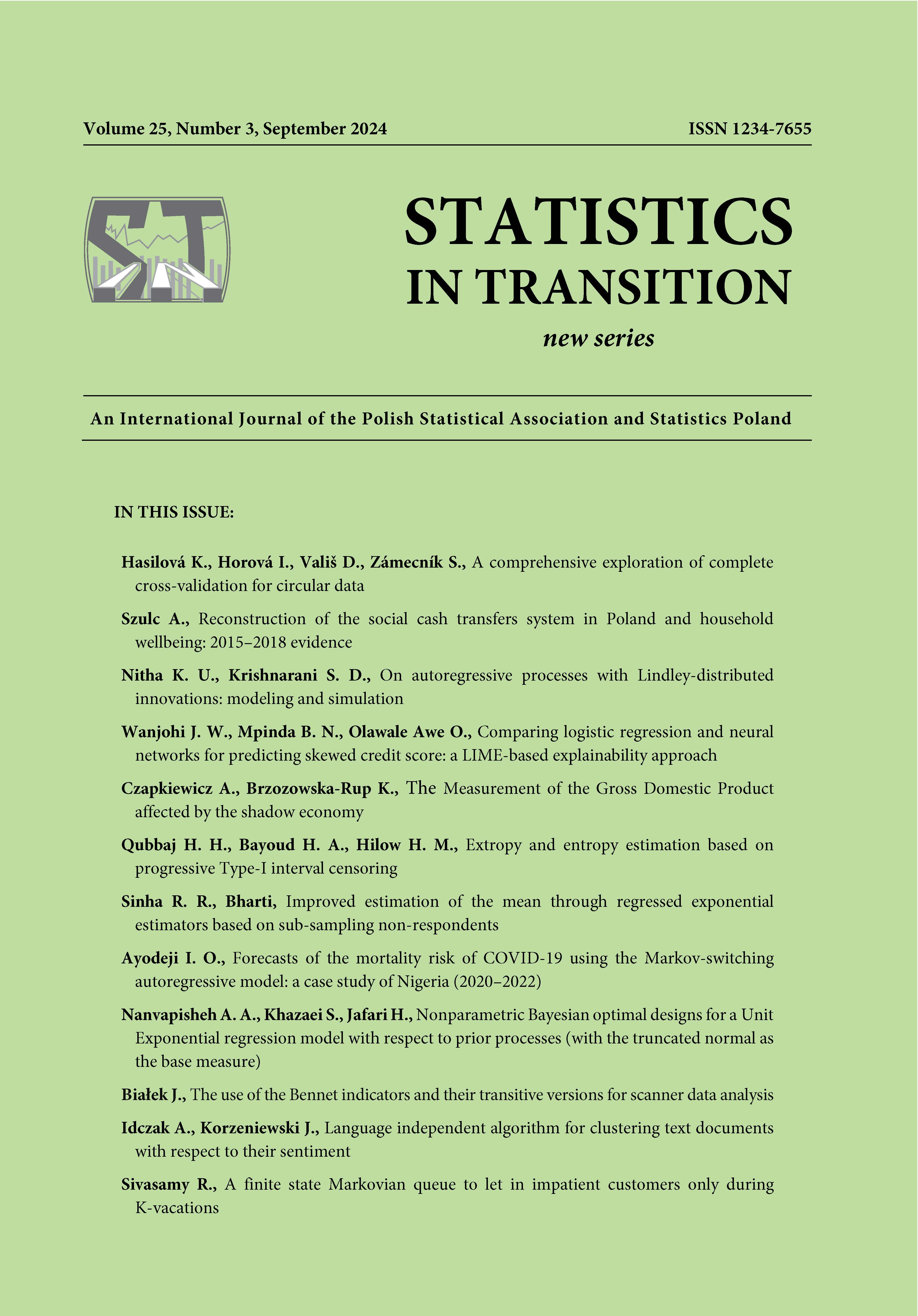ARTICLE
ABSTRACT
The article presents a method for balancing Gross Domestic Product (GDP) when the measurements of its components are distorted by the existence of the shadow economy. Our proposal to measure GDP is based on a multiple ultrastructural model (MUM), where the explanatory variables are subject to error. We show that the expected value of GDP can be divided into two parts: the first part concerns data related to registered activities and the second part concerns unobserved data which may be partly related to the shadow economy. The empirical analysis is based on the annual data for individual voivodeships in Poland for the years 2000–2019. The data are obtained from the Local Data Bank of Statistics Poland. Two approaches to measuring GDP are considered: from the expenditure side and from the production side. The results show that the unobservable part of the variables necessary to balance GDP on the production side does not exceed 1% of GDP, and on the expenditure side, it mostly reaches about 3% of GDP.
KEYWORDS
measurement error, ultrastructural model, Gross Domestic Product, shadow economy.
REFERENCES
Adair, P., (2021). Non-Observed Economy vs. Shadow Economy and Informal Employment in Poland: A Range of Mismatching Estimates. in: W. Andreff (Ed.). Comparative Economic Studies in Europe. Studies in Economic Transition. Palgrave Macmillan, Cham.
Adair, P., (2017). Non-Observed Economy vs. the Shadow Economy in the EU: The Accuracy of Measurements Methods and Estimates revisited. 4 th OBEGEF Interdisciplinary Insights on Fraud and Corruption, Porto, Portugal.
Błasiak, Z. A., (2018). Przydatność metod ekonometrycznych w badaniach nad szara˛strefa˛. Roczniki Ekonomii i Zarządzania, Towarzystwo Naukowe Katolickiego Uniwersytetu Lubelskiego Jana Pawła II, 10.
Breusch, T., (2005). Estimating the Underground Economy using MIMIC Models. Working Paper, Canberra, Australia.
Buszko, A., (2017). The level of shadow economy inWarmińsko-Mazurski and Kujawsko- Pomorski regions. Copernican Journal of Finance & Accounting, 6, pp. 9 –21.
Czapkiewicz, A., Brzozowska-Rup, K., (2021). Szacowanie rozmiar/’ow szarej strefy w Polsce. Wiadomo´sci Statystyczne. The Polish Statistician, 66, pp. 7–24.
Chan, N. N., Mak, T.K. (1984). Heteroscedastic errors in a linear functional relationship. Biometrika, 71, pp. 212–215.
Dolby, G. R., (1976). The Ultrastructural Relation: A Synthesis of the Functional and Structural Relations. Biometrika, 63, pp. 39–50.
Dybka, P., Kowalczuk, M., Olesiński, B., Rozkrut, M., Torój, A., (2017). Currency demand and MIMIC models: towards a structured hybrid model-based estimation of the shadow economy size. SGH KAE Working Papers Series, 2017/030.
Dybka, P., Kowalczuk, M., Olesiński, B, Rozkrut, M., Torój, A., (2019). Currency demand and MIMIC models: towards a structured hybrid method of measuring the shadow economy. Int Tax Public Finance, 26, pp. 4–40.
European Commission, (2010). European system of account (ESA 2010).
Feige, E. L., (1997). Revisited Estimates of Underground Economy: Implications of US Currency Held Abroad, in O. Lippert and M.Walker (eds). The Underground Economy, The Fraser Institute, Canada.
Kirchgässner, G., (2016). On estimating the size of the shadow economy. German Economic Review, 18(1), pp. 99–111.
Kendall, M. G., Stuart A., (1973). The Advanced Theory of Statistics Volume Two. Charles Griffin and Co Ltd, London, Third edition.
Madzarevic-Sujster, S., Mikulic D., (2002). An Estimate of the Underground Economy via the National Accounts System. Institute of Public Finance, Zagreb, 26, pp. 31–56.
Malczewska, P., (2019). Szara strefa gospodarki. Determinanty i mechanizmy kształtowania. Wydawnictwo Uniwersytetu Łódzkiego.
Medina, L., Schneider, F. G., (2019). Shedding Light on the Shadow Economy: A Global Database and the Interaction with the Official One. CESifo Working Paper, 7981.
Schneider, F., (2005a). Shadow Economies around the World: What Do We Really Know? European Journal of Political Economy.
Schneider, F., Dellanno, R., (2005b). The Shadow Economy of Italy and other OECD Countries: What do we know? Journal of Public Finance and Public Choice.
Schneider, F., Buehn, A., (2016). Estimating the Size of the Shadow Economy: Methods, Problems and Open Questions. IZA Discussion Paper, 9820.
Schneider F., Medina L., (2018). Shadow Economies around the World: What Did We LEARN Over the Last 20 Years?. International Monetary FundWorking Paper, WP/18/17.
Trebicka, M., (2014). MIMIC model: A tool to estimate the shadow economy. Academic Journal of Interdisciplinary Studies, 3, pp. 295–300.
Wyżnikiewicz B., (2017). Produkt krajowy brutto jako przedmiot krytyki. Wiadomości Statystyczne, 3, pp. 5–15.
OECD, (2002). Measuring the Non-Observed Economy: A Handbook.
Raport 2015/2016, Przeciwdziałanie szarej strefie w Polsce. The Global Compact Network Poland.
Statistics Poland Local Data Bank, website: https://bdl.stat.gov.pl/BDL/.
